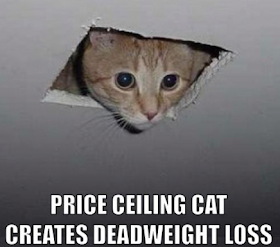2006 Price Ceiling - FRQ#2
Watch me do this FRQ on youtube https://youtu.be/Ux4F3PnCg4w
(A) Using a correctly labeled graph of supply and demand, show each of the following
We see the same pattern being used here. First questions are asked, usually, before any tax, tariff, subsidy happens.
- The equilibrium price and quantity, labeled as P* and Q*. Respectively -- (Respectively is used when enumerating two or more items or facts that refer back to a previous statement).
- area representing consumer surplus, labeled CS
- area representing the producer surplus, labeled PS
Simple enough, yes. but 1point is awarded for the CLG - Correctly Labeled Graph
1point is awarded for the labeling of the CS (consumer surplus)
1point is awarded for the labeling of the PS (producer surplus)
(B) The government imposes an effective(binding) price ceiling. Redraw your graph in part (a), and label the ceiling price as P2. Completely shade the area representing the sum of the consumer surplus and the producer surplus after the imposition of the price ceiling.
We can see that with a binding (below equilibrium) price ceiling at P2,,, only Q1 of quantity will be supplied.
The quantity demanded is Q2 but the amount from Q1 to Q2 will never be supplied at this price.
At the low price of P2 consumer surplus has increased and gained the lower square.
Producer surplus has shrank to the small lower shaded triangle.
I want to point out that the white triangle (unshaded) to the left of the old equilibrium price is now considered DWL or dead weight loss. It represents the consumers and producers who would have liked to buy or sell at a higher price but can't now due to government intervention.
(C) Suppose the demand for home security systems decreases and the price ceiling remains binding. Indicate what will happen to consumer and producer surplus.
So if Demand decreases, the demand curve shifts left. But, because they say in the problem (the price ceiling remains binding) we know that the demand curve has NOT shifted below the P2 price ceiling. Shifting the demand curve will decrease the consumer surplus but the producer surplus will remain unchanged. The producer surplus will only be effected if the supply curve shifts,, or the demand curve shifts far enough to cause the equilibrium price to go lower than P2.




THANK YOU SOOOO MUCH!! I finished my AP Micro homework thanks to you lol.
ReplyDeleteThank you so much :DDDDDDDDD
ReplyDelete